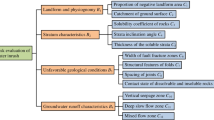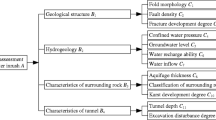Abstract
This paper presents an improved assessment system to evaluate the risk of water inrush in tunnels in carbonate karst terrain based on extension assessment method. This system considers the karst geological conditions and selects nine main factors as evaluation indices that influence the water inrush in tunnels. The evaluation indices are quantitatively graded into four risk grades based on their values or expert judgement. The same-feature matter-element, classical domains, and sectional domains are constructed based on the nondimensionalization of the risk grades of the evaluation indices. The integrated weights for the evaluation indices are composed of the objective weights computed from measured values and the subjective weights derived from the Fuzzy Analytical Hierarchy Process (FAHP). The water inrush risk level of the evaluation object is recognized by the correlation analysis. The variable characteristic value makes it possible to further distinguish the water inrush risk of different objects having the same risk level. The accuracy of the assessment results of this proposed extension assessment system was verified by applying it in two engineering cases. This extension assessment system provides a practical tool to assess the risk of water inrush in tunnels in carbonate karst terrain.
Similar content being viewed by others
References
Cai, W. (1983). “The extension set and non-compatible problem.” Science Exploration, Vol. 3, No. 1, pp. 83–97.
Cai, W. (1999). “Extension theory and its application.” Chinese Science Bulletin, Vol. 44, No. 17, pp. 1538–1548.
Chang, D. Y. (1996). “Applications of the extent analysis method on fuzzy AHP.” European Journal of Operational Research, Vol. 95, No. 3, pp. 649–655, DOI: 10.1016/0377-2217(95)00300-2.
Chu, H., Xu, G., Yasufuku, N., Yu, Z., Liu, P., and Wang, J. (2017). “Risk assessment of water inrush in karst tunnels based on two-class fuzzy comprehensive evaluation method.” Arabian Journal of Geosciences, Vol. 10, No. 7, 179, DOI: 10.1007/s12517-017-2957-5.
Dreybrodt, W. (2012). Processes in karst systems: Physics, chemistry, and geology, Springer Science & Business Media, Berlin & New York, NY, USA, pp. 1–287.
Du, Y. C., Han, X. R., and Li, Z. L. (2009). “Professional evaluating system for karst tunnel gushing based on AHP and its application.” Carsologica Sinica, Vol. 28, No. 3, pp. 281–287.
Goodman, R. E., Moye, D. G., Van Schalkwyk, A., and Javandel, I. (1965). “Ground water inflows during tunnel driving.” Engineering Geology, Vol. 2, No. 1, pp. 39–56.
Heuer, R. E. (1995). “Estimating rock tunnel water inflow.” Proc. Rapid Excavation and Tunnelling Conference 1995, Society for Mining, Metallogy & Exploration, Inc., Englewood, CO, USA, pp. 41–60.
Heuer, R. (2005). “Estimating rock tunnel water inflow - II.” Proc. Rapid Excavation and Tunnelling Conference 2005, Society for Mining, Metallogy & Exploration, Inc., Englewood, CO, USA, pp. 394–407.
Hwang, J. H. and Lu, C. C. (2007). “A semi-analytical method for analyzing the tunnel water inflow.” Tunnelling and Underground Space Technology, Vol. 22, No. 1, pp. 39–46, DOI: 10.1016/j.tust.2006.03.003.
Jin, X., Li, Y., Luo, Y., and Liu, H. (2016). “Prediction of city tunnel water inflow and its influence on overlain lakes in karst valley.” Environmental Earth Sciences, Vol. 75, No. 16, 1162, DOI: 10.1007/s12665-016-5949-y.
Kahraman, C., Ruan, D., and Dogan, I. (2003). “Fuzzy group decision making for facility location selection.” Information Sciences, Vol. 157, pp. 135–153, DOI: 10.1016/S0020-0255(03)00183-X.
Kolymbas, D. and Wagner, P. (2007). “Groundwater ingress to tunnels–the exact analytical solution.” Tunnelling and Underground Space Technology, Vol. 22, No. 1, pp. 23–27, DOI: 10.1016/j.tust.2006.02.001.
Kong, W. K. (2011). “Water ingress assessment for rock tunnels: A tool for risk planning.” Rock Mechanics and Rock Engineering, Vol. 44, No. 6, pp. 755–765, DOI: 10.1007/s00603-011-0163-4.
Li, L., Lei, T., Li, S., Zhang, Q., Xu, Z., Shi, S., and Zhou, Z. (2015). “Risk assessment of water inrush in karst tunnels and software development.” Arabian Journal of Geosciences, Vol. 4, No. 8, pp. 1843–1854, DIO: 10.1007/s12517-014-1365-3.
Li, X. and Li, Y. (2014). “Research on risk assessment system for water inrush in the karst tunnel construction based on GIS: Case study on the diversion tunnel groups of the Jinping II Hydropower Station.” Tunnelling and Underground Space Technology, Vol. 40, pp. 182–191, DOI: 10.1016/j.tust.2013.10.005.
Li, L. P., Li, S. C., Chen, J., Li, J. L., Xu, Z. H., and Shi, S. S. (2011). “Construction license mechanism and its application based on karst water inrush risk evaluation.” Chinese Journal of Rock Mechanics and Engineering, Vol. 30, No. 7, pp. 1345–1354.
Li, S. C., Zhou, Z. Q., Li, L. P., Xu, Z. H., Zhang, Q. Q., and Shi, S. S. (2013). “Risk assessment of water inrush in karst tunnels based on attribute synthetic evaluation system.” Tunnelling and Underground Space Technology, Vol. 38, pp. 50–58, DOI: 10.1016/j.tust.2013.05.001.
Lu, Z., Wu, L., Zhuang, X., and Rabczuk, T. (2016). “Quantitative assessment of engineering geological suitability for multilayer urban underground space.” Tunnelling and Underground Space Technology, Vol. 59, pp. 65–76, DIO: 10.1016/j.tust.2016.06.003.
Mao, B. Y., Xu, M., and Jiang, L. W. (2010). “Preliminary study on risk assessment of water and mud inrush in karst tunnel.” Carsologica Sinica, Vol. 29, No. 2, pp. 183–189.
Marinos, P. G. (2001). “Tunnelling and mining in karstic terrain: An engineering challenge.” Geotechnical and Environmental Applications of Karst Geology and Hydrology: Proceedings of the Eighth Multidisciplinary Conference on Sinkholes and the Engineering and Environmental Impacts of Karsts, Louisville, KY, USA, pp. 3–16.
McFeat-Smith, I., Turner, V. D., and Bracegirdle, D. R. (1985). “Tunnelling conditions in Hong Kong.” Hong Kong Engineer., Vol. 13, No. 6, pp. 13–25.
Raymer, J. H. (2001). “Predicting groundwater inflow into hard-rock tunnels: Estimating the high-end of the permeability distribution.” Proc., Rapid Excavation and Tunnelling Conference 2001, SME, San Diego, CA, USA, pp. 1027–1038.
Saaty, T. L. (1977). “A scaling method for priorities in hierarchical structures.” Journal of Mathematical Psychology, Vol. 15, No. 3, pp. 234–281, DOI: 10.1016/0022-2496(77)90033-5.
Shen, X. M., Liu, P. L., and Wang, J. F. (2010). “Evaluation of waterinrush risks of karst tunnel with Analytic Hierarchy Process.” Journal of Railway Engineering Society, Vol. 12, pp. 56–63.
Wang, Y., Jing, H., Yu, L., Su, H., Luo, N. (2017). “Set pair analysis for risk assessment of water inrush in karst tunnels.” Bulletin of Engineering Geology and the Environment, Vol. 76, No. 3, pp. 1199–1207, DOI: 10.1007/s10064-016-0918-y.
Xu, Z. H, Li, S. C., Li, L. P., Chen, J., and Shi, S. S. (2011). “Construction permit mechanism of karst tunnels based on dynamic assessment and management of risk.” Chinese Journal of Geotechnical Engineering, Vol. 33, No. 11, pp. 1714–1725.
Yang, C. Y., Zhang, Y. J., and Cai, W. (2002). “Study on extension set and its applications.” Mathematics in Practice and Theory, Vol. 32, No. 2, pp. 301–308.
Zhang, L. and Franklin, J. A. (1993). “Prediction of water flow into rock tunnels: An analytical solution assuming an hydraulic conductivity gradient.” International Journal of Rock Mechanics and Mining Sciences & Geomechanics Abstracts, Vol. 30, No. 1, pp. 37–46, DOI: 10.1016/0148-9062(93)90174-C.
Zhang, Q., Li, S., Ge, Y., Xu, Z., and Liu, R. (2011). “Study on risk evaluation method of water inrush and integrated geological prediction technology in high-risk karst tunnel.” Geotechnical Special Publication, Vol. 220, pp. 285–291.
Zhang, K., Tannant, D. D., Zheng, W., Chen, S., and Tan, X. (2018). “Prediction of karst for tunnelling using fuzzy assessment combined with geological investigations.” Tunnelling and Underground Space Technology, Vol. 80, pp. 64–77, DOI: 10.1016/j.tust.2018.06.009.
Zhou, Z. Q., Li, S. L., Li, L. P., Shi, S. S., Song, S. G., and Wang, K. (2013). “Attribute recognition model of fatalness assessment of water inrush in karst tunnels and its application.” Rock and Soil Mechanics, Vol. 34, No. 3, pp. 818–826.
Zhou, Z. Q., Li, S. C., Li, L. P., Shi, S. S., and Xu, Z. H. (2015). “An optimal classification method for risk assessment of water inrush in karst tunnels based on grey system theory.” Geomechanics and Engineering, Vol. 8, No. 5, pp. 631–647, DOI: 10.12989/gae.2015.8.5.631.
Author information
Authors and Affiliations
Corresponding author
Rights and permissions
About this article
Cite this article
Zhang, K., Zheng, W., Xu, C. et al. An Improved Extension System for Assessing Risk of Water Inrush in Tunnels in Carbonate Karst Terrain. KSCE J Civ Eng 23, 2049–2064 (2019). https://doi.org/10.1007/s12205-019-0756-0
Received:
Revised:
Accepted:
Published:
Issue Date:
DOI: https://doi.org/10.1007/s12205-019-0756-0




